Page 22 of 162
Status indicators220
Overview
The following table lists the possible warnings and pages with additional information.
Light Symbol Meaning Explanations
Ignition key not authorised. (
b 22)
Low-beam headlight, high-beam
headlight, parking light or turn signal
lamp defective. (b 24)
Defective lamp. (b 24)
yellow Fuel reserve reached. (b 22)
yellow Fault in engine electronics. (b 23)
yellowRear light or brake light lamp
defective. (b 24)
red Coolant temperature too high. (b 22)
red Engine oil pressure too low. (b 23)
Page 24 of 162
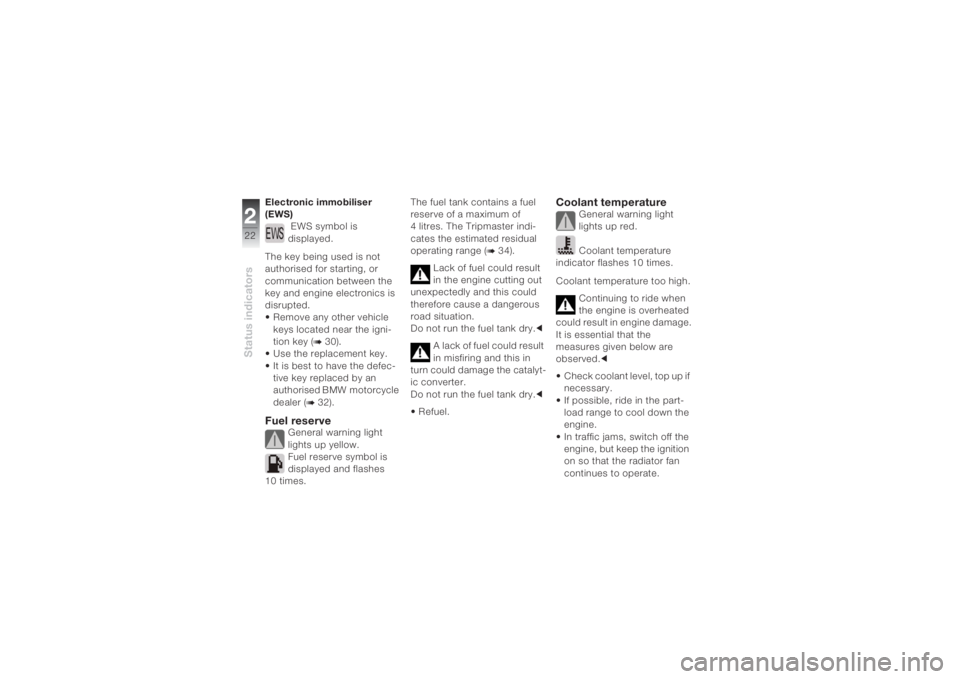
Status indicators222
Electronic immobiliser
(EWS)
EWS symbol is
displayed.
The key being used is not
authorised for starting, or
communication between the
key and engine electronics is
disrupted.
• Remove any other vehicle
keys located near the igni-
tion key (
b 30)
.
• Use the replacement key.
• It is best to have the defec-
tive key replaced by an
authorised BMW motorcycle
dealer (
b 32).
Fuel reserve
General warning light
lights up yellow.
Fuel reserve symbol is
displayed and flashes
10 times.The fuel tank contains a fuel
reserve of a maximum of
4 litres. The Tripmaster indi-
cates the estimated residual
operating range (
b 34).
Lack of fuel could result
in the engine cutting out
unexpectedly and this could
therefore cause a dangerous
road situation.
Do not run the fuel tank dry.c
A lack of fuel could result
in misfiring and this in
turn could damage the catalyt-
ic converter.
Do not run the fuel tank dry.c
•Refuel.
Coolant temperature
General warning light
lights up red.
Coolant temperature
indicator flashes 10 times.
Coolant temperature too high.
Continuing to ride when
the engine is overheated
could result in engine damage.
It is essential that the
measures given below are
observed.c
• Check coolant level, top up if
necessary.
• If possible, ride in the part-
load range to cool down the
engine.
• In traffic jams, switch off the
engine, but keep the ignition
on so that the radiator fan
continues to operate.
Page 32 of 162
Operation330
Ignition switch and
steering lockKeysYou will receive one master
key and one spare key. If a key
is lost, please note the infor-
mation on the EWS electronic
immobiliser (
b 22).
Ignition switch and steer-
ing lock, tank filler cap
lock and seat lock are all oper-
ated with the same key.
System casesOA can also be
operated on request using the
same key.c
Switching on the ignition• Turn the key to position U.
» Parking light and all function
circuits switched on.
» Pre-ride check is carried out
(b 53).
» ABS self-diagnosis is
performed (
b 54).
» Engine can be started.
Switching off the ignition• Turn the key to position V.
» Light switched off.
» Steering lock unsecured.
» In this position, you can
remove the key.
Page 33 of 162
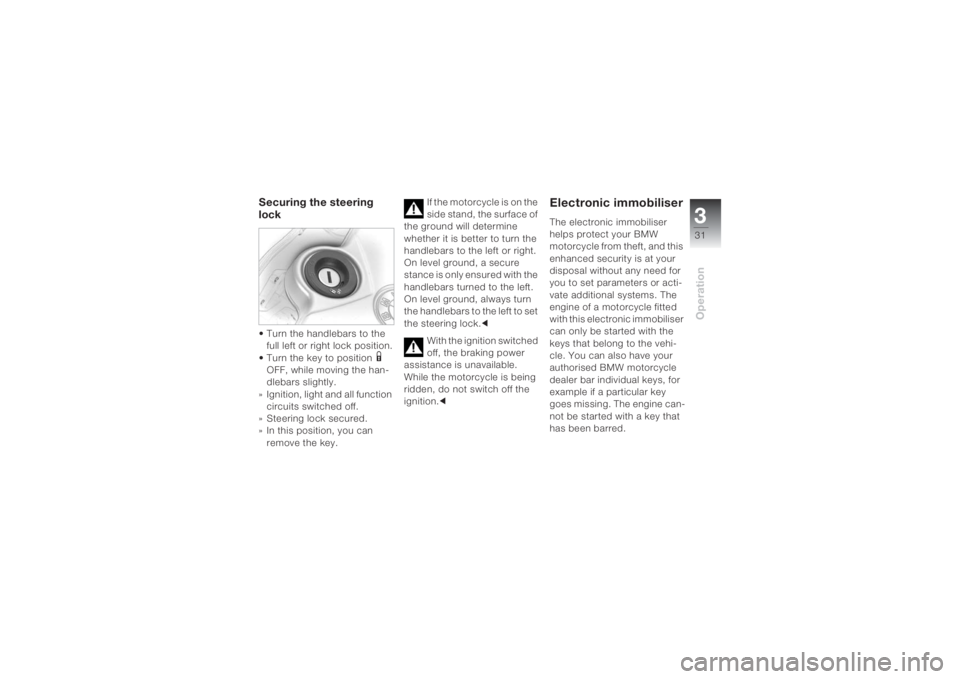
331Operation
Securing the steering
lock• Turn the handlebars to the
full left or right lock position.
• Turn the key to position
1
OFF, while moving the han-
dlebars slightly.
» Ignition, light and all function
circuits switched off.
» Steering lock secured.
» In this position, you can
remove the key.If the motorcycle is on the
side stand, the surface of
the ground will determine
whether it is better to turn the
handlebars to the left or right.
On level ground, a secure
stance is only ensured with the
handlebars turned to the left.
On level ground, always turn
the handlebars to the left to set
the steering lock.c
With the ignition switched
off, the braking power
assistance is unavailable.
While the motorcycle is being
ridden, do not switch off the
ignition.c
Electronic immobiliserThe electronic immobiliser
helps protect your BMW
motorcycle from theft, and this
enhanced security is at your
disposal without any need for
you to set parameters or acti-
vate additional systems. The
engine of a motorcycle fitted
with this electronic immobiliser
can only be started with the
keys that belong to the vehi-
cle. You can also have your
authorised BMW motorcycle
dealer bar individual keys, for
example if a particular key
goes missing. The engine can-
not be started with a key that
has been barred.
Page 34 of 162
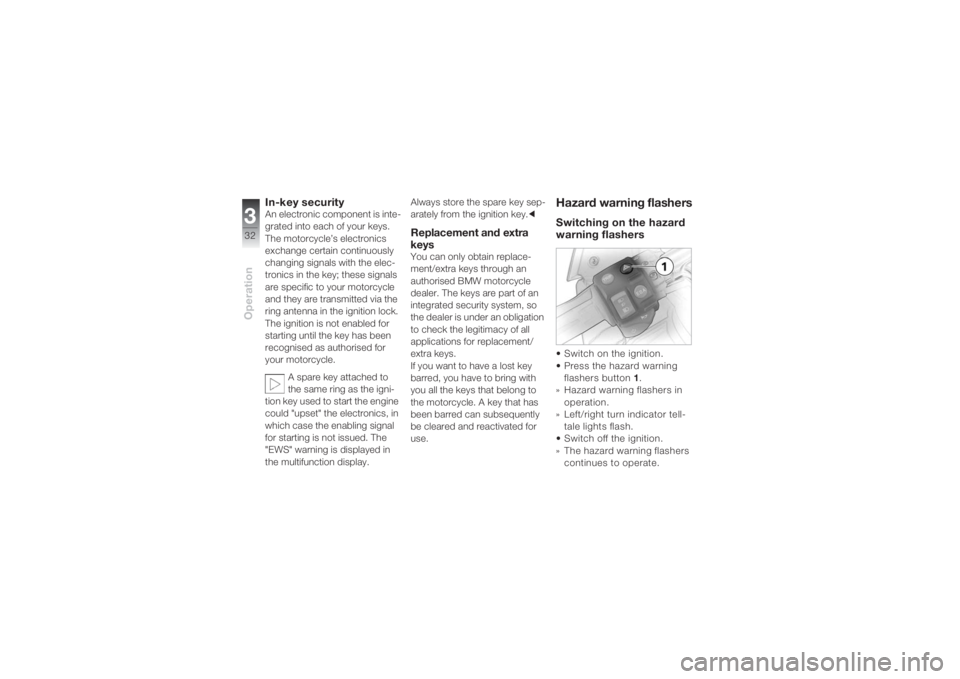
Operation332
In-key securityAn electronic component is inte-
grated into each of your keys.
The motorcycle’s electronics
exchange certain continuously
changing signals with the elec-
tronics in the key; these signals
are specific to your motorcycle
and they are transmitted via the
ring antenna in the ignition lock.
The ignition is not enabled for
starting until the key has been
recognised as authorised for
your motorcycle.
A spare key attached to
the same ring as the igni-
tion key used to start the engine
could "upset" the electronics, in
which case the enabling signal
for starting is not issued. The
"EWS" warning is displayed in
the multifunction display. Always store the spare key sep-
arately from the ignition key.c
Replacement and extra
keysYou can only obtain replace-
ment/extra keys through an
authorised BMW motorcycle
dealer. The keys are part of an
integrated security system, so
the dealer is under an obligation
to check the legitimacy of all
applications for replacement/
extra keys.
If you want to have a lost key
barred, you have to bring with
you all the keys that belong to
the motorcycle. A key that has
been barred can subsequently
be cleared and reactivated for
use.
Hazard warning flashersSwitching on the hazard
warning flashers• Switch on the ignition.
• Press the hazard warning
flashers button 1.
» Hazard warning flashers in
operation.
» Left/right turn indicator tell-
tale lights flash.
• Switch off the ignition.
» The hazard warning flashers
continues to operate.
Page 42 of 162
Operation340
Switching off the turn
indicators• Press indicator button 3.
»Turn indicator off.
» Turn indicator telltale light is
off.
SeatRemoving the seat • Turn the key anticlockwise in
the seat lock. • When doing so, press the
seat downwards for support.
• Raise the seat at the rear.
• Let go of the key and pull the
seat from the retaining
brackets towards the rear.
Setting down the seat• Place the seat with the cov-
ered side downwards on a
smooth and clean surface.
For example, place the
seat with the covered
side downwards on the fuel
tank and the handlebars.c
Page 69 of 162
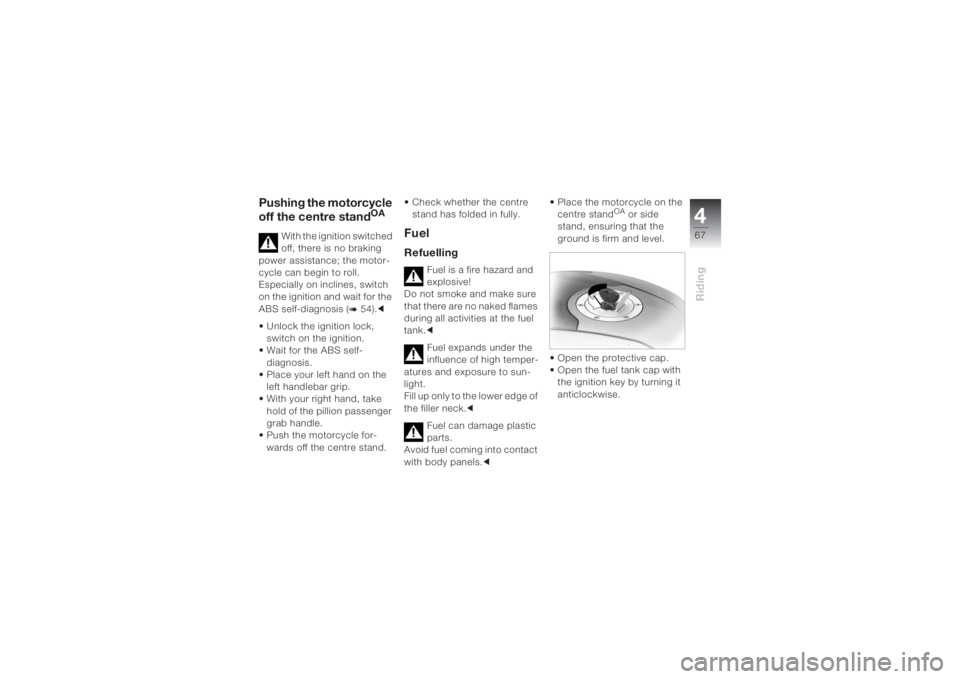
467Riding
Pushing the motorcycle
off the centre stand
OA
With the ignition switched
off, there is no braking
power assistance; the motor-
cycle can begin to roll.
Especially on inclines, switch
on the ignition and wait for the
ABS self-diagnosis (
b 54).c
• Unlock the ignition lock,
switch on the ignition.
•Wait for the ABS self-
diagnosis.
• Place your left hand on the
left handlebar grip.
• With your right hand, take
hold of the pillion passenger
grab handle.
• Push the motorcycle for-
wards off the centre stand.• Check whether the centre
stand has folded in fully.
Fuel Refuelling
Fuel is a fire hazard and
explosive!
Do not smoke and make sure
that there are no naked flames
during all activities at the fuel
tank.c
Fuel expands under the
influence of high temper-
atures and exposure to sun-
light.
Fill up only to the lower edge of
the filler neck.c
Fuel can damage plastic
parts.
Avoid fuel coming into contact
with body panels.c• Place the motorcycle on the
centre stand
OA or side
stand, ensuring that the
ground is firm and level.
• Open the protective cap.
• Open the fuel tank cap with
the ignition key by turning it
anticlockwise.
Page 70 of 162
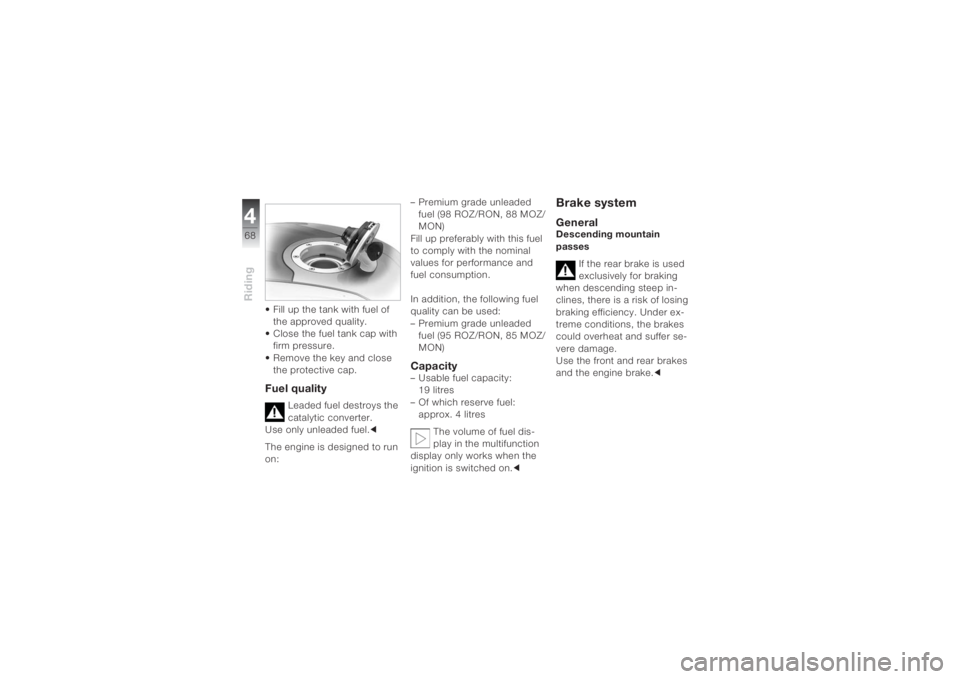
Riding468
• Fill up the tank with fuel of
the approved quality.
• Close the fuel tank cap with
firm pressure.
• Remove the key and close
the protective cap.Fuel quality
Leaded fuel destroys the
catalytic converter.
Use only unleaded fuel.c
The engine is designed to run
on:– Premium grade unleaded
fuel (98 ROZ/RON, 88 MOZ/
MON)
Fill up preferably with this fuel
to comply with the nominal
values for performance and
fuel consumption.
In addition, the following fuel
quality can be used:
– Premium grade unleaded
fuel (95 ROZ/RON, 85 MOZ/
MON)
Capacity– Usable fuel capacity:
19 litres
– Of which reserve fuel:
approx. 4 litres
The volume of fuel dis-
play in the multifunction
display only works when the
ignition is switched on.c
Brake system GeneralDescending mountain
passes
If the rear brake is used
exclusively for braking
when descending steep in-
clines, there is a risk of losing
braking efficiency. Under ex-
treme conditions, the brakes
could overheat and suffer se-
vere damage.
Use the front and rear brakes
and the engine brake.c